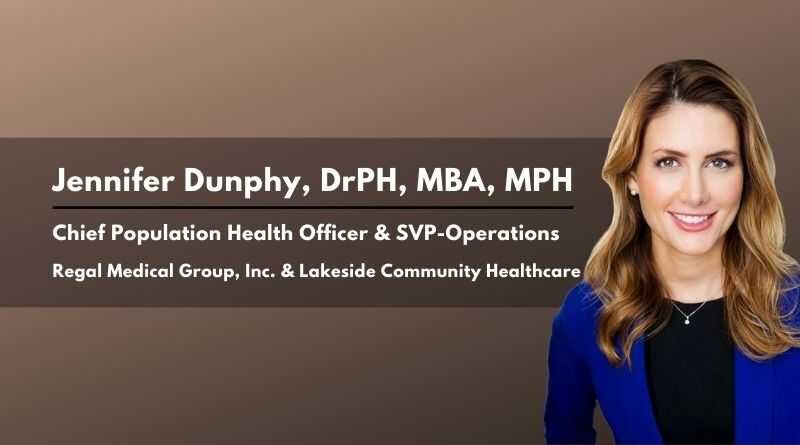COVID-19: Destruction and Innovation in Population Health
By Jennifer Dunphy, DrPH, MBA, MPH, Chief Population Health Officer & SVP-Operations, Regal Medical Group, Inc. & Lakeside Community Healthcare
The world has seen widespread upheaval in the new environment of COVID-19, healthcare-at-large, and specifically, the domain of population health are no exceptions. Time-tested business models have been overturned in a matter of weeks, healthcare interactions with patients have been revolutionized, and necessary services have been distinguished from nice-to-haves. The world looks a lot different now, and it is becoming clear that some of these new processes and innovations are here to stay, even in a post-COVID world.
The long term implications for population health and public health are staggering. We are seeing an increased awareness among patient populations when it comes to understanding personal risk, and from that comes an enhanced willingness to connect and manage conditions (although not through in-person visits). This is in part because COVID-19 has allowed health officials to offer clear and simple guidelines which delineate those who are high-risk from those that are not in COVID-19 terms: if you have a pre-existing condition or are over 65, you are high risk. These easy-to-understand risk definitions seem to be making an impact as nothing has before. These “labels” are fostering a sense of newfound agency for those with a chronic condition and highlight emerging opportunities for managing the chronic disease for payers and providers—opportunities that extend far beyond the corona virus.
Many of our most effective population health models rely on in-person interactions, particularly home visits. These home-based visits are especially critical when it comes to serving vulnerable populations with social issues.
We have noticed a positive shift in engagement from patients willing to take a closer look at their conditions and participate in their own care through various mediums, including virtual healthcare. We have noticed an increase in patients’ willingness to try new technologies that they were previously uninterested in engaging with—examples include video teleconferencing services and health monitoring devices that send updates to providers. But, this level of engagement is just scratching the surface—as virtual care becomes more of the norm rather than the exception, we will discover a host of new touchpoints that open up access and encourage patient-centered care.
We have also witnessed overall increased scrutiny in the efficacy of health services that have operated in the same way for decades, if not centuries, all because there was no impetus for change. COVID-19, in many ways, has become that impetus. We are forced to look closer at what services are making an impact for patients, and which are mere vestiges of an ineffective and outdated health system. An example of this is how patients are scheduled, and in turn, wait for their doctor’s appointments. Because of fear of crowded waiting rooms amidst the coronavirus, providers are allowing for virtual check-ins and more efficient scheduling processes. Patients now often wait in their car and participate in no-touch checkouts. This has dramatically increased the efficiency of getting patients in and out of the office resulting in an increase in consumer and provider satisfaction as well as the added benefit of decreasing the spread of infectious germs.
Although Covid-19 has brought many unforeseen benefits in its ability to galvanize innovation, we have simultaneously come across a host of challenges. Many of our most effective population health models rely on in-person interactions, particularly home visits. These home-based visits are especially critical when it comes to serving vulnerable populations with social issues. We have found these in-person interactions to be critical tools that allow us to have insight into patients’ health status that would be difficult or impossible to garner virtually. These insights help us to develop more robust relationships and encourage trust and compliance. For many, it is their first touchpoint with the health system and our medical group. Unfortunately, with the advent of COVID-19, we have had to suspend any in-home interactions with patients—this initially left our model in disarray. We were no longer able to provide the type of in-home services to our patients that we usually do, such as fall assessments and observing first-hand the risks present in the home environment. Technological requirements for this population were another challenge onto itself. These individuals often did not have the type of devices necessary to do video calls nor the knowledge to operate them (unassisted). This provided an enormous obstacle for our team. There is not an easy fix to a situation like this—when you rely on a type of interaction that is no longer possible in a hard-to-reach, indigent population where you are also grappling with cultural and language barriers. Certainly, telehealth can help us bridge some of these gaps, such as video conferencing, but there are inevitably holes that cannot be plugged.
Now for the first time, we are being forced to evolve a technology resistant model into one that fully embraces new tech in the search for workable solutions that make the connection possible. This means finding or developing innovations that put the patient first and make real connection possible in the absence of being in the same space.
Our work has taught us that we have the highest chance of being successful in terms of engagement and sustainability if we can leverage pre-existing relationships and then use technology to build off of those connections. Examples include telemedicine with an already established provider or a video visit with a patient care navigator that has a long-standing relationship with the patient.
As we wade through this new normal, it has become our job to understand that while technology is helpful, it certainly is not the panacea. We are going to lose connections with patients. We will have some people fall through the cracks. We are going to miss some elements an in-person visit would have captured. However, we cannot deny that without these new advances, we would have little alternatives to continue providing what we deem as often life-saving services.



